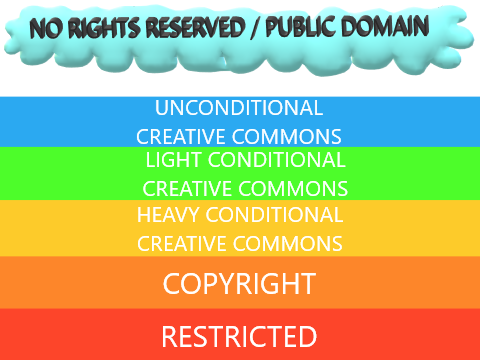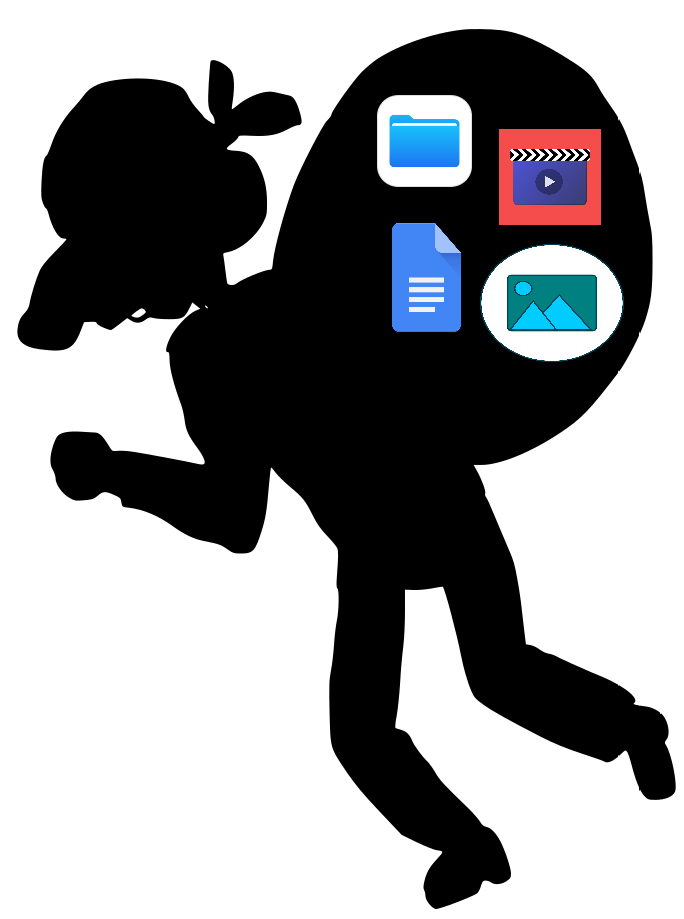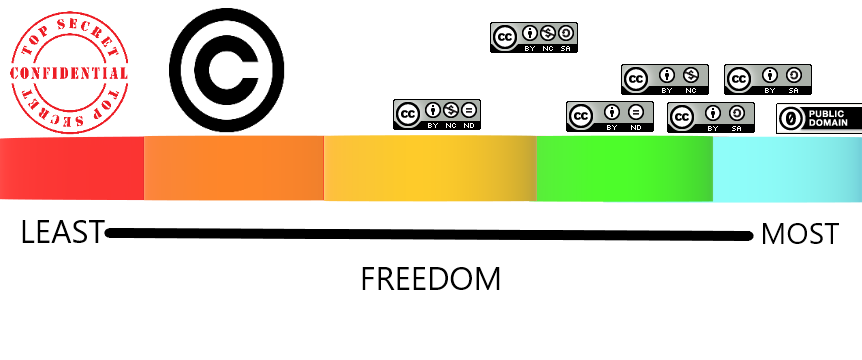Creative Commons Licenses

Freedom Level Detail
Outline
Intellectual property refers intangible creations which is usually resulted from the mind and almost always published. For example, articles, images, audios, videos, and games, even this article that you are reading that I wrote is an intellectual property. The license of your creations must be taken seriously at the very least declaring yourself as the creator, even using nicknames or naming yourself as anonymous is okay, or at the very least, the precise date and time of the creation is there. Otherwise, others can take the work. If they openly share, is positive, but negatively they can put license on the work meaning, claiming the work as theirs where potentially even you lose all rights to your work, meaning you can’t even use including apply, publish, share, and modify.

Content Thief
In these modern times during the writing of these article, copyright is automatically given to you on any work that you named. This means that you have full right to your work which includes giving permission to others. In many online platforms usually, you don’t need to put your name manually because they will automatically put your registered name whenever you post a content. If you post on your own platform and forgot to put your name, cross you fingers hoping the timestamp is recorded because if it is recorded, it can be as a proof that your content is published by someone anonymous where it will remain open freely until you give proof that you are the owner of the content.
By holding the copyrights of your contents means that others always have to ask your permission to use your contents which includes sharing, modifying, and republishing. If others infringed these rights, it can be considered a crime. However, this becomes a hindrance if your intention is really sharing for free. That is where creative commons license comes in.
Creative Commons Licenses
.png) Creative commons licenses give every person and organization in the world a free, simple, and standardized way to grant copyright permissions for creative and academic works; ensure proper attribution; and allow others to copy, distribute, and make use of those works. Below are the list of license condition when using a work:
Creative commons licenses give every person and organization in the world a free, simple, and standardized way to grant copyright permissions for creative and academic works; ensure proper attribution; and allow others to copy, distribute, and make use of those works. Below are the list of license condition when using a work:
 Attribution (by) requires to give credit to the credit with at least mentioning the creator’s name. You can additionally add the links to the creation or write a full reference format that includes authors, date, title, content location, and publisher.
Attribution (by) requires to give credit to the credit with at least mentioning the creator’s name. You can additionally add the links to the creation or write a full reference format that includes authors, date, title, content location, and publisher. ShareAlike (sa) allows sharing but with the condition of using the same license. For example when a content is licensed free and open by the creator, you must also share it for free and open and require others to do the same when sharing your already shared contents.
ShareAlike (sa) allows sharing but with the condition of using the same license. For example when a content is licensed free and open by the creator, you must also share it for free and open and require others to do the same when sharing your already shared contents. NonCommercial (nc) prohibits of selling, taking profit, and everything else related to commercial.
NonCommercial (nc) prohibits of selling, taking profit, and everything else related to commercial. NoDerivatives (nd) prohibits any modification such adding characters, adding strokes to images, creating other formats such as html and pdf, and etc. The content must absolutely remain as it is.
NoDerivatives (nd) prohibits any modification such adding characters, adding strokes to images, creating other formats such as html and pdf, and etc. The content must absolutely remain as it is.
Freedom Level of Common Licenses

Content Thief
Below are the level order of the freedom from most to least:
 No Rights Reserved (cc0). Do you think creative commons attribution is the most free license? Well, you are wrong. The most free license is public domain or no rights reserved where the contents are totally free and open that does not require crediting to the creators. Different from without license where anyone can claim the contents and license them anytime, public domains are license open and its licensed cannot be modify or overwritten by anyone. For example, the Internet, bitcoin and other open blockchain networks, and electricity. Some of the most simplest examples are the characters we write, the dots and lines we draw, and the language we speak, we don’t to give attributions whenever we use them. Well at least to humans and other creators. If you are religious, maybe you are taught to thank the creator of the world or universe (whatever you believe in) everytime for example when you drink and eat because foods and drinks are rightly belongs to the creator of the world, we are only given and lent.
No Rights Reserved (cc0). Do you think creative commons attribution is the most free license? Well, you are wrong. The most free license is public domain or no rights reserved where the contents are totally free and open that does not require crediting to the creators. Different from without license where anyone can claim the contents and license them anytime, public domains are license open and its licensed cannot be modify or overwritten by anyone. For example, the Internet, bitcoin and other open blockchain networks, and electricity. Some of the most simplest examples are the characters we write, the dots and lines we draw, and the language we speak, we don’t to give attributions whenever we use them. Well at least to humans and other creators. If you are religious, maybe you are taught to thank the creator of the world or universe (whatever you believe in) everytime for example when you drink and eat because foods and drinks are rightly belongs to the creator of the world, we are only given and lent. Creative Commons Attribution (cc-by): a license that grants others to use, share, modify, republish, and even for commercial without permission with the only condition of giving credit to the creators.
Creative Commons Attribution (cc-by): a license that grants others to use, share, modify, republish, and even for commercial without permission with the only condition of giving credit to the creators. Creative Commons Attribution ShareAlike (cc-by-sa): a license that grants others to use, share, modify, and republish with two conditions of (1) giving credit to the creators and (2) must also share with the same license. In other words, others must give credits, share for free, and others who shares this already shared content must also do the same (must give credits, share for free, requires other sharers to do the same). If I’m not wrong, you can make it commercial but not directly. The contents must remain open where you are still allowed get profits through donations, monetization, etc. For example, you open a seminar, show, radio, etc about the content where you can charge people for the service but you are not allow to sell the contents, you can still put them in advertisements, and you can merge them with your products but the price must exclude the cc-by-sa contents which is like you sell a product but get the cc-by-sa contents free and others must be allowed to share those contents with the same cc-by-sa.
Creative Commons Attribution ShareAlike (cc-by-sa): a license that grants others to use, share, modify, and republish with two conditions of (1) giving credit to the creators and (2) must also share with the same license. In other words, others must give credits, share for free, and others who shares this already shared content must also do the same (must give credits, share for free, requires other sharers to do the same). If I’m not wrong, you can make it commercial but not directly. The contents must remain open where you are still allowed get profits through donations, monetization, etc. For example, you open a seminar, show, radio, etc about the content where you can charge people for the service but you are not allow to sell the contents, you can still put them in advertisements, and you can merge them with your products but the price must exclude the cc-by-sa contents which is like you sell a product but get the cc-by-sa contents free and others must be allowed to share those contents with the same cc-by-sa. Creative Commons Attribution NonCommercial (cc-by-nc): a license that grants others to use, share, modify, and republish with two conditions of (1) giving credit to the creators and (2) prohibited to commercialize such as selling, taking profits, etc.
Creative Commons Attribution NonCommercial (cc-by-nc): a license that grants others to use, share, modify, and republish with two conditions of (1) giving credit to the creators and (2) prohibited to commercialize such as selling, taking profits, etc. Creative Commons Attribution NoDerivatives (cc-by-nd): a license that grants others to use, share, modify, and republish with two conditions of (1) giving credit to the creators and (2) prohibited to derive and modify where it must be shared as it is. ShareAlike (sa) is not required here, because NoDerivatives (nd) already restricts to share the work as it is which it was originally opened so it must always be opened in the same form. It can still be commercialize but limited like putting the exact contents into a blog or video and receive money based on advertisements, donations, etc.
Creative Commons Attribution NoDerivatives (cc-by-nd): a license that grants others to use, share, modify, and republish with two conditions of (1) giving credit to the creators and (2) prohibited to derive and modify where it must be shared as it is. ShareAlike (sa) is not required here, because NoDerivatives (nd) already restricts to share the work as it is which it was originally opened so it must always be opened in the same form. It can still be commercialize but limited like putting the exact contents into a blog or video and receive money based on advertisements, donations, etc. Creative Commons Attribution NonCommercial ShareAlike (cc-by-nc-sa): like the cc-by-sa but exclude all the commercial parts which includes charity and monetization, even advertisements.
Creative Commons Attribution NonCommercial ShareAlike (cc-by-nc-sa): like the cc-by-sa but exclude all the commercial parts which includes charity and monetization, even advertisements. Creative Commons Attribution NoDerivatives (cc-by-nc-nd): like the cc-by-nd but exclude all the commercial parts which includes charity and monetization, even advertisements.
Creative Commons Attribution NoDerivatives (cc-by-nc-nd): like the cc-by-nd but exclude all the commercial parts which includes charity and monetization, even advertisements..png) Copyright all rights reserved, which I explained in previous sections that the anyone who wants to use, share, modify, or republish the contents must ask for permission to the holder of the copyright. It is in default given when creating contents.
Copyright all rights reserved, which I explained in previous sections that the anyone who wants to use, share, modify, or republish the contents must ask for permission to the holder of the copyright. It is in default given when creating contents..png) Restricted, private, secret, or confidential. Do you think copyright gives the least freedom? Unfortunately, I found licenses not written in the book that is less free than copyrighted. In almost all platform you can set your post to private where either only you can see or with whom people you grant access to. Outside of contents, privacy is a common thing, for example most people prefer privacy when changing their clothes, going to the washroom, keeping a diary, their identification cards, etc. You probably have heard the saying, “please keep it a secret” or “this document is confidential” where if you tell anybody, you are breaking the code of secrecy. Finally, restricted, yes there are even online contents that are restricted such as adult sites where for example it is restricted for anyone below 18 years old and even if younger audience can access, they are violating the law and can be arrested. A different example is accessing a server’s system, it is restricted only to administrators and its members where even if you find and use their IDs means you are stealing their IDs and if you force your way in means you are hacking. Another awkward case is maybe you stumble upon a restricted content in public due to the creators’ mismanagement, even though it is there for you to see but you should not and ignore it, just like when your sister left her diary in the dining hall where you should either ignore, call her, or close the diary and give it to her hoping that she believes you that you did not read the contents.
Restricted, private, secret, or confidential. Do you think copyright gives the least freedom? Unfortunately, I found licenses not written in the book that is less free than copyrighted. In almost all platform you can set your post to private where either only you can see or with whom people you grant access to. Outside of contents, privacy is a common thing, for example most people prefer privacy when changing their clothes, going to the washroom, keeping a diary, their identification cards, etc. You probably have heard the saying, “please keep it a secret” or “this document is confidential” where if you tell anybody, you are breaking the code of secrecy. Finally, restricted, yes there are even online contents that are restricted such as adult sites where for example it is restricted for anyone below 18 years old and even if younger audience can access, they are violating the law and can be arrested. A different example is accessing a server’s system, it is restricted only to administrators and its members where even if you find and use their IDs means you are stealing their IDs and if you force your way in means you are hacking. Another awkward case is maybe you stumble upon a restricted content in public due to the creators’ mismanagement, even though it is there for you to see but you should not and ignore it, just like when your sister left her diary in the dining hall where you should either ignore, call her, or close the diary and give it to her hoping that she believes you that you did not read the contents.
License of My Online Contents
I’ve known about creative commons for years now but I only explored its type of licenses recently. My personal blogs and Youtube videos are license under creative common attribution for years because it was only one I knew other that copyright. I didn’t put license on my posts on other platforms which are not personal because I simply forgot where usually I just need to set on the footer.
Now I would like to properly license all of my online contents including this article. The license I choose is  Creative Commons Attribution-CustomizedShareAlike 4.0 International License. I Fajar Purnama as the creator customized the ShareAlike (sa) license here where you are also allowed to sell my contents but with a condition that you must mention that the free and open version is available here. In summary, the mention must contain the keyword “free” and “open” and the location such as the link to this content.
Creative Commons Attribution-CustomizedShareAlike 4.0 International License. I Fajar Purnama as the creator customized the ShareAlike (sa) license here where you are also allowed to sell my contents but with a condition that you must mention that the free and open version is available here. In summary, the mention must contain the keyword “free” and “open” and the location such as the link to this content.
Mirror
- https://www.publish0x.com/0fajarpurnama0/creative-commons-licenses-xvkevo?a=4oeEw0Yb0B&tid=github
- https://0darkking0.blogspot.com/2020/04/creative-commons-licenses.html
- https://medium.com/@0fajarpurnama0/creative-common-licenses-dab10b401584
- https://0fajarpurnama0.github.io/misc/2020/04/12/creative-common-license
- https://0fajarpurnama0.tumblr.com/post/615205384112783360/creative-common-licenses
- https://hicc.cs.kumamoto-u.ac.jp/~fajar/tmp/creative-common-license
- https://steemit.com/copyright/@fajar.purnama/creative-commons-licenses?r=fajar.purnama
- https://0fajarpurnama0.cloudaccess.host/index.php/uncategorised/32-creative-commons-licenses
- https://hive.blog/copyright/@fajar.purnama/creative-commons-licenses?r=fajar.purnama
- http://0fajarpurnama0.weebly.com/blog/creative-commons-licenses
- https://0fajarpurnama0.wixsite.com/0fajarpurnama0/post/creative-commons-licenses
- http://www.teiii.cn/creative-commons-licenses